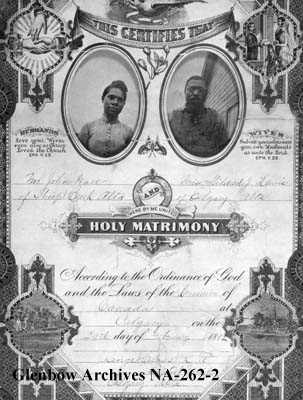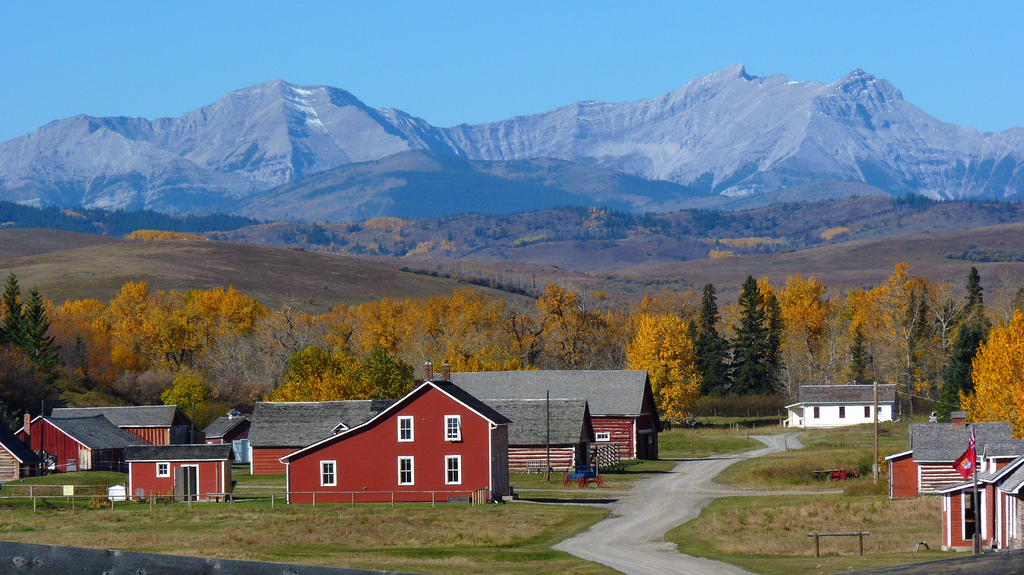John Ware, cowboy, rancher (born circa 1845–50 in the United States; died 11 September 1905 near Brooks, AB). John Ware is legendary in the history of Alberta for his strength, skilled farming techniques and skilled horsemanship. Born enslaved, he became a successful rancher who settled his first ranch near Millarville (near Calgary, Alberta) and his second ranch near Brooks, Alberta. Despite widespread anti-Black racism and discrimination, he was widely admired as one of the best ranchers and cowboys in the West. (See also Black Canadians.)
Click here for definitions of key terms used in this article.

Early Life
Most historical sources on John Ware are accounts written by his friends and acquaintances long after his death. Ware himself could neither read nor write. In addition, according to author, historian and public speaker Cheryl Foggo, he did not share specific details about his early life with his five surviving children. For these reasons, historians are unable to confirm many details of his life, especially those of his youth.
Ware’s exact date and place of birth have not been confirmed by historians. However, his marriage registration from 1892 lists Tennessee as his place of birth. Some sources indicate that Ware was born enslaved in the United States (see also Black Enslavement in Canada). His skill as a rancher suggests that he worked with horses while enslaved. It is likely that Ware gained his freedom at the close of the American Civil War (1865). Although details of his journey west are unknown, he eventually found his way to Texas.
Did you know?
The origin of the word cowboy has racist roots. Before the American Civil War, enslaved Black men and women worked alongside white ranchers. White ranchers were called cow-hands, but enslaved Black workers were referred to as cow-boys. The word boy was used to infantilize and disrespect a Black rancher.The meaning of the word cowboy has changed over time. It is now used to refer to a person who herds and tends cattle and horses. (See also Cowboys and Cowgirls in Canada.)
Ranching Career
When John Ware became a free man, cattle ranching was spreading across the Midwestern United States. He travelled west and honed his skill as a cowboy. An experienced cowhand by the late 1870s, he worked driving herds of Texas cattle northward along the Western Cattle Trail to the distant ranges in Montana.
In 1882, he was hired in Montana to help bring 3,000 head of cattle from the United States to Sir Hugh Allan’s North-West Cattle Co, which was located in the foothills southwest of Calgary, Alberta. Ware found that experienced cowboys were much in demand in this part of the North-West Territories, as it was called then. He remained in the area and worked for several large cattle companies, including Bar U Ranch, until 1884. In the mid-1880s, he started working for the new Quorn Ranch on Sheep River. The ranch soon bought a large herd of cattle and began to raise horses intended for the English market. Ware worked as a lead hand with cattle and managed Quorn’s horse herd.
In the springs of 1884 and 1885, Ware joined many other cowboys in two large roundups from Fort Macleod to search the foothills from Calgary to the Montana border for cattle.
Excerpt from the Macleod Gazette, Fort Macleod, 23 June 1885“John is not only one of the best natured and most obliging fellows in the country, but he is one of the shrewdest cow men, and the man is considered pretty lucky who has him to look after his interest. The horse is not running on the prairie which John cannot ride.”
Before the second roundup began, Ware registered his own cattle brand in 1885. It was known as the 9999 (four-nines) or walking-stick brand. In 1887, Ware established his own ranch on the foothills near Millarville, near the Sheep River. Later in 1898, he re-registered his brand as 999 ( three-nines).

Did you know?
While many stories about John Ware emphasize his physical feats, he was also known for his skills as a farmer. Ware is recognized as one of the first ranchers in the Millarville area to develop an irrigation system for his crops.
Later Life and Family
In 1891, Ware met Mildred Lewis, who had moved from Toronto, Ontario, to the outskirts of Calgary with her family. The couple married in 1892. They established their homestead at Ware’s Millarville ranch and had six children, one of whom died as a baby. In 1902, as more settlers arrived in the area, the family moved. The new ranch site was located along the Red Deer River north of Brooks, near Duchess, Alberta. The home was destroyed by the spring flood of 1902. Ware rebuilt on higher ground.

The family did not occupy the new home for long. At the end of March 1905, Mildred died of pneumonia. In September 1905, Ware was killed when his horse tripped in a badger hole and fell on him. Ranchers from across the region attended his funeral in Calgary. They mourned him as one of their community’s most respected members.
The Wares’ five children were taken in by Mildred’s parents, Daniel and Charlotte Lewis. They lived variously in Blairmore and Calgary. Eventually, the Ware daughters, Mildred and Janet (Nettie), lived near Vulcan, Albert. Two of the couple’s sons, Arthur Nelson Ware and William James Ware, later joined the No. 2 Construction Battalion, the only all-Black battalion in Canadian military history. The couples’ son Robert Lewis Ware and daughter Janet Amanda “Nettie” Ware ensured that their father was respectfully commemorated.
The Legend of John Ware
People came to view John Ware as a hero for his great physical strength, horsemanship, skills as a rancher, good nature and courage. His true story is difficult to separate from the legends about him. This is because there are few records about his life or details left directly by John Ware. Most of what is known about him was written by fellow cowboys. However, those accounts did not begin to appear until the late 1930s after Ware’s death. Historians have little information from his family members. His wife died before him and he died while his children were very young.
Did you know?
Many stories about John Ware focus on his strength and skill with cattle and horses. He was said to have walked over the backs of penned steers without fear. Legend holds that he could also:
- – stop a steer head-on and wrestle it to the ground
- – break (train) the wildest broncos
- – hold a horse on its back to be shod with horseshoes
- – easily lift an 18-month-old steer and throw it on its back for branding.
Though stories about Ware contain exaggerations, his status as regional folk hero show how well respected he was. The traits he is said to have had are typical of frontier heroes of cowboy culture. What distinguishes him the most, however, is how successfully he established himself on his own terms in 19th-century Canadian society, where anti-Black prejudice and discrimination were common.
Commemoration
In southern Alberta, several places near the site of John Ware’s first ranch are named after him. These include Mount Ware, Ware Creek and John Ware Ridge. There is also a memorial cairn near the location of his former Millarville ranch. Calgary is home to John Ware Junior High. At the Southern Alberta Institute of Technology, the John Ware Building houses the 4 Nines Dining Centre.
In February 2012, during Black History Month, Canada Post issued a stamp in honour of John Ware. In 2022, the Government of Canada designated John Ware a person of national historic significance.
Albertan director Cheryl Foggo premiered the play John Ware Reimagined in 2014. Her documentary film called John Ware Reclaimed was released for the National Film Board of Canada in 2020. That same year, Howdy, I’m John Ware, a children’s book written by Ayesha Clough and illustrated by Hugh Rookwood, was published.

Key Terms
Brand: A mark burned on the hide of livestock with hot iron that identifies its owner.
Cattle: Large ruminant animals with divided hoofs. Ruminant means they chew the half-digested food returned to their mouths from the first chamber of the stomach. Cattle include cows, oxen, bison and buffalo.
Cowboy (or cowhand): A person, usually mounted on a horse, who herds and tends cattle or horses. (See also Cowboys and Cowgirls in Canada.)
Folk hero: A person who is greatly admired by the common people.
Ranch: A farm where cattle or horses are raised.
Roundup: The act of gathering cattle by riding around them and driving them closer together. A roundup served to count the animals or register their ownership.
Steer: A castrated male of cattle (i.e., one that has had its testicles removed as part of the process of raising it for beef). (See also Beef Cattle Farming.)
Western Cattle Trail: A route along which cowboys in Ware’s time moved cattle northward from Texas, passing through Oklahoma, Kansas and Nebraska. It was also called the Dodge City Trail or the Texas Trail.
This article was edited with files from author, historian and public speaker Cheryl Foggo.

 Share on Facebook
Share on Facebook Share on X
Share on X Share by Email
Share by Email Share on Google Classroom
Share on Google Classroom











